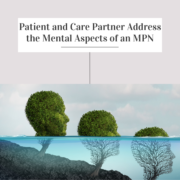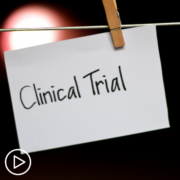Tag Archive for: MPN
Three Reasons MPN Patients and Their Families Should Continue Telemedicine
What are some reasons why MPN patients and families should continue to use telemedicine visits? In the “Should MPN Patients and Their Families Continue Telemedicine?” program, expert Dr. Kristen Pettit from Rogel Cancer Center shares three ways myeloproliferative neoplasm (MPN) patients and families can benefit from continuing to use telemedicine for care.
1. Access to Care
One of the most impactful benefits to patients from the COVID-19 pandemic has been the emergence of telemedicine. Telemedicine has brought improved access to MPN experts, care teams, and specialty cancer centers via smartphone, tablet, or computer to broaden expert care for patients and care partners. Many family members or friends can now join telemedicine visits to help ask questions and to take notes for more engaged patient care.
2. Safety and Travel Benefits
The use of telemedicine has also brought safety and travel benefits. Patients and care partners have reduced the amount of time they spend in clinics and waiting rooms. Their risk of infection with viruses, bacteria, and other illnesses has been decreased when some of their MPN care appointments can be carried out remotely. And reduced travel to appointments helps patients and care partners in lowering travel costs and stress related to commuting or scheduling rides.
3. Remote Monitoring
MPN patients must also empower themselves to keep track of their health concerns to ensure their remote monitoring is reported accurately. Patients and care partners can monitor any weight changes, enlargement or feeling of fullness with their spleen, feeling overly tired or fatigued, and other symptoms their care provider has mentioned as symptoms to be aware of. If you have any questions about symptoms, make sure to ask your doctor.
By continuing to take advantage of telemedicine, MPN patients and care partners can reap the benefits of remote care paired with in-person visits as advised by your doctor. If you’d like to expand your knowledge, check out our MPN information.
Thriving With MPNs: Your Role in Managing Your Treatment and Care
Thriving With MPNs: Your Role in Managing Your Treatment and Care from Patient Empowerment Network on Vimeo.
How can patients thrive with a myeloproliferative neoplasm (MPN)? Dr. Jeanne Palmer discusses treatment approaches, strategies for managing disease symptoms and treatment side effects, and advice on how patients can be proactive in their care.
Dr. Jeanne Palmer is a hematologist specializing in myeloproliferative neoplasms (MPNs) and bone marrow transplant at the Mayo Clinic in Arizona. Dr. Palmer also serves as Director of the Blood and Marrow Transplant Program and is Vice Chair and Section Chief for Hematology. Learn more about Dr. Palmer, here.
Related Programs:

How Should You Participate in MPN Care and Treatment Decisions? |

|

|
Transcript:
Katherine Banwell:
Hello and welcome. I’m Katherine Banwell, your host for today’s program. Today, we’re going to talk about how to live and thrive with an MPN. We’re going to discuss MPN treatment goals and how you can play an active role in your care. Before we get into the discussion, please remember that this program is not a substitute for seeking medical advice. Please refer to your healthcare team about what might be best for you.
Well, joining us today is Dr. Jeanne Palmer. Dr. Palmer, welcome. Would you please introduce yourself?
Dr. Jeanne Palmer:
Thank you so much. I am so happy to be here and to help participate in this. My name is Jeanne Palmer. I am a hematologist at Mayo Clinic in Arizona. I specialize in MPNs as well as bone marrow transplant, and I am thrilled to be here.
Katherine Banwell:
Thank you for taking the time out of your busy schedule to join us today, Dr. Palmer. We start all of the webinars in our Thrive series with the same question and that is, what does it mean to you to thrive with an MPN?
Dr. Jeanne Palmer:
I think living with an MPN can be very difficult. I think there is a number of things. First of all, there’s always the worry of what’s going to happen in the future. Many of these MPNs can start as fairly, for lack of a better term, as benign issues and can convert to something much more serious. So, I think living with that sort of timebomb in the back it can be extremely stressful. So, figuring out how to live with the fact that there is some degree of uncertainty.
I think the other thing is making sure to understand your disease. These are very rare disorders and even if you go to a hematologist-oncologist specialist, a lot of times they don’t have all the information because they don’t see a lot of them every year. So, it’s really important to make sure that above and beyond that you understand what’s going on in your body so that when new things happen, new symptoms happen, you’re able to really address them as opposed to sort of living with something that may make you feel poorly that’s not being addressed.
So, again, I think the biggest piece of this is seeing how do you live with uncertainty, and how do you make sure you understand your disease well enough that you know what’s going on in your own body.
Katherine Banwell:
Yeah. That’s helpful to understand, especially as we move through today’s program, and we’re going to cover the three classic MPNs, polycythemia vera, essential thrombocythemia and myelofibrosis. One part of thriving with an MPN is managing the symptoms of the disease. Would you walk us through the common symptoms of each of the MPNs? Let’s start with essential thrombocythemia.
Dr. Jeanne Palmer:
Right. So, there are a number of shared symptoms throughout all the diseases and when we start to figure out how to categorize them, they call into several different categories. The first one is inflammation-related symptoms. We know that the inherent pathway that’s dysregulated or that causes these diseases to happen can also result in significant inflammation in a person, that can result in things like fevers, night sweats, weight loss, and overall feeling really fatigued and poorly, which is something that it seems to be much more prevalent in patients with MPNs, all sorts of them, actually.
The next set of symptoms is related to microvasculature, so all the little blood vessels. And sometimes we think, oh, maybe that’s because there’s too many red blood cells or platelets and the blood become viscous. It’s probably more related to the actual dysregulation of that JAK2 pathway, which is inherent to all the myeloproliferative diseases and as a result, the little blood vessels can clamp down and that can give people headaches, visual changes, numbness and tingling in the hands and feet, and even can cause sort of a painful rash called erythromelalgia in the body.
So, these are things that can happen that are probably less appreciated side effects of the disease. And finally, there’s spleen-related symptoms. The spleen is in the left upper quadrant of the abdomen and it’s an organ that generally is about 12 centimeters in length, 10 to 12, but in patients with myeloproliferative diseases it can be enlarged. And as a result of an enlarged spleen people can have feeling like they get fuller early. So, if you’re eating a meal, all of the sudden you can only eat half of that meal versus the whole meal.
Discomfort or pain in the left upper quadrant. Sometimes it’s much more noticeable when you like bend over to tie your shoes. And then sometimes people can actually, when the spleen gets really big, the blood flow can be impaired towards the end of it which can cause some of the spleen tissue to die, and that can be painful. So, these are things that if somebody does start to notice that they’re having fullness in the left upper quadrant, pain, stuff like that, that that may be related to spleen symptoms.
Katherine Banwell:
What about PV or polycythemia vera, what are the symptoms?
Dr. Jeanne Palmer:
So, all of these sorts of relate to all of the myeloproliferative diseases. So, one other one that I didn’t mention, and this is actually more in PV than others, is itching. Itching can be absolutely unbearable when somebody has PV. It’s particularly noticeable after taking a shower. So, a lot of times I’ve met patients who are like I haven’t been able to take a shower in years, because it causes such a high degree of itching.
Katherine Banwell:
Why a shower? Is it different from having a bath?
Dr. Jeanne Palmer:
Water on the body that can cause the problem. So, if people take hot showers, it’s even worse. Although I think that people sort of react to it differently. Usually what patients end up doing is more like sponge bath type of things, rather than actually being exposed to the water.
Taking colder showers or cooler showers can sometimes help mitigate that. But the itching, and even in the absence of a shower, people can have pretty severe itching, and that can also be one of the major side effects.
Katherine Banwell:
Much of the time the chosen treatment for MPNs manages the symptoms of the condition. I’d like to review the different types and classes of treatment for the three MPNs. So, let’s start with essential thrombocythemia again. When is it time to treat, and what are the options available?
Dr. Jeanne Palmer:
Right. So, with essential thrombocythemia, that’s the disease that sometimes we don’t need to treat.
So, we basically have a risk stratification system and this risk is based on age, history of a blood clot, the presence or absence of a JAK2 mutation. So, for example, if somebody is 28, does not have a JAK2 mutation, which is again one of those driver mutations, and never had a blood clot, they actually don’t necessarily need to do anything and just be monitored.
Somebody who is less than 60 and has a JAK2 mutation or who is greater than 60 and does not have a JAK2 mutation, in that setting, a lot of times you can use aspirin. Now, it gets a little bit gray in terms of that over 60 without the JAK2 mutation with regards to whether at that point you really should start taking some medicine to lower the platelets.
Now, if somebody has a JAK2 mutation, is greater than 60 or has had a blood clot, hands down they need to take medicine to lower the platelets, in addition to aspirin or whatever blood thinner they may need. So, for example, if you have a blood clot in a vein, a lot of times you need to take a blood thinner and that will be a lifelong thing. And again, we do these risk stratifications because we know there is a certain risk of clotting associated with the risk of essential thrombocythemia.
So, for example, somebody who is less than 60 and does not have a JAK2 mutation, never had a clot, their risk of clotting is probably very close to that of the normal population. Whereas if you’re higher risk and have a JAK2 mutation and greater than 60 or have had a history of a clot, the risk of clot is probably about 4 percent per year. So, this is something that can vary quite widely, and even though that 4 percent per year on the short-term doesn’t sound like a lot, if you take it additive over years, that’s why we generally try to be aggressive about lowering the platelets.
In lowering the platelets, the goal is to get less than 400 and doing that can be done through several different medications. The most commonly used medications is a drug called hydroxyurea, which has been around for a number of years, and a drug called anagrelide which is probably a little less commonly used, because it has some more GI side effects and headaches associated with it.
In some cases, especially in younger patients with this disease, we can consider using interferon, which is an injection of a cytokine, which are one of the chemicals that regulates the immune system within the body. But this interferon can actually help lower the platelets and there is a question of whether it may affect the biology of the disease as well.
Katherine Banwell:
Let’s turn to polycythemia vera or PV, what are the different options available for treating it?
Dr. Jeanne Palmer:
So, for polycythemia vera, everyone needs to be on aspirin.
And additionally, everyone needs to make sure to keep their blood count low, to manage their hematocrit, which is one of the measures of red blood cells. So, in men it’s generally recommended to keep below 45 and in women it’s recommended to keep below 42 percent. Now, the studied number was 45 percent and that was a study that was done, I don’t know, it was probably about 10 plus years ago, that actually showed that by keeping the blood hematocrit less than 45 percent you reduce the risk of having negative events like cardiovascular events and heart attacks. Because women tend to run with a lower blood count than men, it’s been extrapolated that 42 percent should be the number used for women.
Now, this can be done by phlebotomy, which essentially is bloodletting. It’s kind of like donating blood except for that the blood unfortunately can’t be donated to anybody, it has to be discarded. But the phlebotomy is one way to do that, and the reason that works is because it makes somebody iron deficient. So, whereas if this is normal, if you’re iron deficient you become anemic. If your baseline hematocrit is here, making you iron deficient brings you back to normal. So, even though we always associate iron deficiency with anemia, iron deficiency in the setting of polycythemia vera is actually kind of a treatment of sorts.
Now, once somebody gets above 60 and 60 seems to be sort of the magic age in these diseases, once somebody gets above 60, it is recommended that cytoreductive therapy is used, which means therapy or treatment that will bring down the red count. And again, for this one, hydroxyurea is an option as well as interferon. And there is recently an approval, actually FDA approval for a newer interferon called ropeginterferon or Besremi, which can help just bring down the red blood cells but it is the first interferon that’s actually been FDA approved for this indication.
Katherine Banwell:
Are JAK inhibitors used as well?
Dr. Jeanne Palmer:
They are. So, if somebody doesn’t respond well to hydroxyurea, the approval for ruxolitinib is actually for patients who have failed hydroxyurea. Although it’s something that we often consider especially in people who have a lot of symptoms. So, the itching, one of the things that can really help itching actually is Jakafi. If people have night sweats, they have weight loss, spleen related symptoms, those are the patients that will benefit from Jakafi. Additionally, if they are on hydroxyurea and can’t seem to get control of their blood count, Jakafi is a good option to help control the blood counts as well.
Interferon is a very nice option because there’s great data that shows that you may actually be able to lower the percentage of JAK2 burden.
So, we’d look at something called an allele burden, which is the percentage of cells that are involved – have the JAK2 mutation. Now, we don’t know whether lowering this percentage necessarily translates to long-term better survival, but I think there is enough data out there, and there is a good biologic underpinning for saying that this actually can help. But yes, Jakafi is another thing.
And the really exciting thing is that there is a newer agent called rusfertide, which is a hepcidin mimetic, which is basically taking a protein in your body that helps metabolize iron and by making it externally and giving it to somebody that it can actually help bring down the hematocrit without having some of the other side effects we know with some of the other medications. That is currently in Phase III studies, so hopefully in the next couple of years we’ll see approval for that.
Katherine Banwell:
Oh, that’s great news. And finally, how is myelofibrosis treated?
Dr. Jeanne Palmer:
So, myelofibrosis is a little bit of a different animal. When you have something like essential thrombocythemia or PV, a lot of this is managing symptoms, preventing blood clots, but if you do appropriate treatment and management of these diseases you could probably live close to a normal life expectancy.
So, I never typically pin a survival on it. With myelofibrosis, it’s a little bit different because there is a survival. Instead of saying you can live close to normal life expectancy, it backs up to saying how many years do I think you can live with this disease. Now, of course, we are horrible at predicting how many years anyone can live, so we have to take that all with a grain of salt. But we can at least sort of risk stratify people.
And the first thing that’s really important is to figure out whether somebody is a transplant candidate or not and if, based on age, disease risk features, stuff like that, or whether we think they ever will be a transplant candidate. So, that kind of helps us sort of think about what your path moving forward is.
Now, the current FDA-approved treatment for myelofibrosis, there are three JAK inhibitors approved, which is like Jakafi, which was the first approved one but there is also Inrebic or fedratinib and Vonjo or pacritinib and these have all been approved over the years.
The role of JAK inhibitors and treatment of myelofibrosis is symptoms-based. So, for example, a lot of patients with myelofibrosis will have weight loss, night sweats, big spleens, really feeling fatigued and poorly and in this setting, the JAK inhibitor can be very helpful. And you don’t have to have a JAK2 mutation, a lot of times people say, well, I don’t have the JAK2 mutation so how can a JAK inhibitor help. So, the JAK inhibitor works on this pathway, which is called the JAK/STAT pathway, irrespective of mutation.
So, if you are having symptoms and you have myelofibrosis, JAK mutation, excuse me, the JAK2 mutation does not predict who is going to have a response. And people who, regardless of which mutation you have, may actually benefit from it.
So, the JAK inhibitors, though, are extremely effective at reducing symptom burden as well as reducing the spleen size. And we know that if a spleen is big and we can make it shrink that, that probably is a surrogate marker for living longer, and I think it’s because inflammation does a lot of wear and tear on the body. So if you can reduce the inflammation and the spleen shrinks, which generally go hand in hand, then you might help somebody live longer. It is not changing the biology of the disease, though, however, it doesn’t change the pathway and that this disease is kind of projecting ahead in terms of creating – it changes, as it goes along, may acquire new mutations or something like that which makes the disease become more serious.
Right now, the approved therapies for it are JAK inhibitors and the Jakafi, ruxolitinib was the first one approved. Inrebic was approved several years back, or fedratinib.
And then the most recent one that was approved is Vonjo or pacritinib and that’s a drug that is a JAK inhibitor that is actually very good for people with low platelets. The reason I bring that up is because if we think of what’s the biggest limiter of JAK inhibitors, JAK inhibitors bring down red blood cells, and they bring down platelets. So, when somebody has low platelets it’s very hard to use a JAK inhibitor, because we’re not really able to increase the dose well enough to get that inflammatory reduction because of the fact that the blood counts will drop too low.
So, now drugs like Vonjo exist which, due to several other mechanisms associated with the drug are actually much more tolerated in somebody with low platelets. So, if you have low platelets, you can actually take the Vonjo, hopefully get the same degree of JAK inhibition to help the spleen shrink, help the symptoms get better without necessarily making the platelets substantially worse. A lot of times they do drop, it doesn’t help bring up the platelets, but it does help people tolerate more JAK inhibition, which ultimately will help with symptoms.
Dr. Jeanne Palmer:
So, one thing I also wanted to add about myelofibrosis treatment is sometimes people present, they don’t have a lot of symptoms, they don’t have a lot of spleen related problems but they have anemia or low blood counts and these can be incredibly hard to treat.
Even with symptoms and low red blood cell count or anemia or low platelets, it can be challenging to treat because many of these medications lower that. To treat the anemia there are several things that we can do. One of the first ones is using erythropoietin, and so there are many agents, they go by the names of like Procrit or darbepoetin alfa, that actually stimulate red blood cell growth by – like we give a recombinant hormone that helps red blood cells grow. This is normally something produced by the kidney.
So, one thing that’s important before going on one of these injections is to make sure that the kidney is not already producing enough. So, for example, if the kidney said, oh geez, I really need more red cells and is making lots of this hormone, erythropoietin, giving more of it is not going to help the system. But in people who don’t have a really high level it can be very beneficial.
The other thing that can help with anemia, specifically, is a drug called danazol (Danocrine).
It’s been around for a very long time. There are multiple presumed mechanisms of action, but one of them is that it is kind of a testosterone derivative. So, this is a medicine that can often help increase red blood cells in probably about 40 percent of people, and it’s a pill that you take twice a day.
Another option, sometimes we use thalidomide or lenalidomide (Revlimid). These are medications that have been used quite frequently in the setting of multiple myeloma and even a little bit in myelodysplastic syndrome, so some other blood disorders.
But in the setting of myelofibrosis, they can be helpful with anemia and sometimes are combined with prednisone or a corticosteroid. And then finally, in terms of drugs that are being tested and hopefully will be approved at some point in the future. There is a drug called momelotinib, which is another JAK inhibitor that actually has some mechanisms that may also help improve hemoglobin.
So, this is something I’m really looking forward to and we anticipate may be approved by the end of the year. And finally, there is another drug called luspatercept (Reblozyl). Luspatercept may work in the setting where your kidneys are already producing enough erythropoietin. So, the luspatercept is an injection that you receive once every three weeks.
It is currently FDA-approved for the treatment of myelodysplastic syndrome but this is something that has been shown to have some efficacy in myelofibrosis as well. So, this could be another therapeutic option for patients with myelofibrosis.
It is also important, especially for people who have polycythemia vera myelofibrosis to make sure that your iron has been checked and B-12 has been checked, because just because you have a bone marrow disorder doesn’t necessarily mean you don’t have a nutrition deficit that may be able to help improve your hemoglobin somewhat. But these are important things to talk to your doctor. I do not recommend just starting to take iron or B-12, however, if you’re anemic because in many cases you are not deficient and taking too much iron can actually be damaged.
Katherine Banwell:
Yeah, that’s great advice.
When would you consider a stem cell transplant?
Dr. Jeanne Palmer:
So, the stem cell transplant is based on disease risk. There is a number of ways we assess disease risk. The first two ones that were published a number of years back were the DIPSS score, which is Dynamic International Prognostic System Score, or the DIPSS Plus, which basically is the DIPSS and then you add to it a few other clinical features. This symptom score is based largely on things that we can see without even a bone marrow biopsy, so things like symptoms, age, number of white blood cells, whether somebody has anemia. And then the number of something called blasts, which is very immature white blood cells. The DIPSS Plus takes into account low platelets, need for transfusions, and chromosome abnormalities, which is the only test among that that needs to be from a bone marrow biopsy.
Now, these were created prior to Jakafi being commercially available. So, we have to take a little bit of a grain of salt with those because of the fact that Jakafi probably has changed how long people can live with this disease.
Now, more recently they’ve tried to account for these other molecular changes. So, when we take the genetic landscape of these diseases, we have the known driver mutations, so the JAK2 mutation which I have talked about, also calreticulin and MPL.
These three mutations all affect that one pathway, the JAK/STAT pathway, so they all affect the pathway that drives the disease and they are known to be kind of mutually exclusive and definitely contribute to the formation of the disease.
Some of these other mutations are called somatic mutations. They could be checked by things next generation sequencing or genetic analysis. There’s a number of different names that people use for this testing, but we look for mutations that are present and these mutations, number one, can sometimes tell us risk. So, there’s certain mutations that are high risk. Other times it can actually give us other opportunities for therapy, especially of the disease progresses. But these mutations are important to know for risk stratification. For example, if somebody has DIPSS score that is maybe not super high risk, but then they have one of these mutations, we know that that probably makes their disease a little bit more aggressive.
And that’s when we think about transplant, is when we know that the disease probably has an average life – when somebody gets to the point in their disease where we estimate their life expectancy is around five years, recognizing that we’re not very good at this. That is the type of point when we start to think about transplant. But the timing of transplant is something that’s extremely difficult and a very personalized decision. It’s something that it’s really important to understand the disease risks, how we assess them and the caveats of these disease risk assessments as we move forward planning and timing of transplant and that’s something that is, again, a very, very important discussion to have at length with your physician.
And I always recommend, there is quite a few of us out there who actually specialize in transplant for myelofibrosis and having discussions with somebody who really understands the biology of the myelofibrosis and important because it’s very different than a lot of the other diseases that are transplanted.
Katherine Banwell:
Yeah. Well, speaking of that, patients can sometimes feel like they’re bothering their healthcare team with their comments and questions. Why do you think it’s important for patients to speak up when it comes to symptoms and side effects?
Dr. Jeanne Palmer:
Well, there is a lot of things. This is a disease, again, that we can direct our therapy many times towards symptoms, and so when we think about how do I direct my therapy, so how do I treat somebody, symptoms are an incredibly important part of it. And there is nothing worse than having a patient come and see me who I see every six months, because they’ve been pretty stable and they’re like, “Oh, for three months I’ve been feeling awful.” And you’re like, well, “Why didn’t you let me know, we could do something about this?”
So, if there is something that doesn’t feel right, it’s very, very important to talk to your healthcare provider. I would much rather be bothered and handle something earlier on than miss something and really have a lot more catch-up to do afterwards.
The other thing is symptoms may indicate a blood clotting event. We know that patients will have a higher risk of blood clotting. These are extremely important to identify early on because if they go unchecked, they can cause more damage.
Katherine Banwell:
With many of the treatments available as pills now, patients have a role in self-administering their treatment regimen. What happens if a patient forgets to take a medication? Does it impact its effectiveness?
Dr. Jeanne Palmer:
Generally no. I think the ones that would are certain blood thinners you really don’t want to miss and you don’t want to miss the doses on it. With drugs like Jakafi, if you miss one dose you probably won’t notice it, but if you miss multiple doses you can actually get very sick from that. So, some of these medications are really important to be consistent on.
Now, I know this could be a challenge. I mean I don’t take very many medications and I sometimes have a hard time keeping track of what I take, so I know that this can be a difficult thing to do. So, one thing is if you really find you’re struggling with it, setting an alarm on your phone or your Apple Watch or whatever…
Katherine Banwell:
…device.
Dr. Jeanne Palmer:
Device you have can be a really helpful way of doing it. Also having a pill box. They make pretty amazing pill boxes these days that can account for taking drugs once a day, twice a day, three times a day. I’ve even seen them up to four times a day, although generally the most you’ll probably have to take a medicine for a myeloproliferative disease is twice a day. But those are different ways that can really help make sure you’re consistent about taking your medication.
Katherine Banwell:
And if a patient misses a dose, do they need to call their healthcare team and let them know?
Dr. Jeanne Palmer:
Not just for one missed dose. If like, for example, they’re run out and they say, “Oh, geez, I don’t have any and many of these drugs are specialty pharmacy,” so they need to be mailed, and you know that you’re going to be missing it for a while. Or let’s say you look at your pill bottle and go, “Oh shoot, I only have so many pills left,” it is helpful to call because a lot of times, for example, if somebody is on Jakafi and they know they’re going to run out of their pills four days before they’re going to get their next shipment in, then what I sometimes do is I lower the dose a little bit to make sure they maintain a dose throughout that time.
But this is something you definitely want to do under the advice of a healthcare provider. You don’t want to just all of the sudden go, “Oh, well I’m going to run out so I’m just going to change my dose,” and kind of do that.
Katherine Banwell:
Yeah, yeah. We received some audience questions prior to the program today. This one is from Jacqueline, “What can I do to minimize pruritus or itching due to PV? A typical histamine blocker like Claritin or Zyrtec has done nothing whatsoever.”
Dr. Jeanne Palmer:
Yeah. Unfortunately, the itching of this is not as much mediated by an allergic type reaction or histamine. It’s a lot related to that microvasculature, those tiny little blood vessels. Things like avoiding hot showers, as we talked about, taking cooler showers or not even taking showers, just like cleaning yourself with a washcloth can be helpful. There are certain medications that we can use sometimes that help.
Now, first of all, Jakafi is extremely effective for itching. Of course, it does have side effects. It’s not always approved for your disease, so for example, it’s not approved for essential thrombocythemia. But JAK inhibitors can be helpful in that setting. There are also medications like Gabapentin, which is a medicine that we use to treat peripheral neuropathy and that can actually be helpful because actually the itching, a lot of it is related to nerves not functioning right, so gabapentin can be helpful.
And a really old-school medicine that I sometimes use, especially if the itching is most prevalent at night, is a drug called Doxepin and that’s been around for a very long time, but it can be extremely sedating and has to be used with caution, especially in patients who are older.
Katherine Banwell:
Here is a question from Daniel. “How often should a person with PV have hematology appointments, and how often should you have blood tests?”
Dr. Jeanne Palmer:
Well, that is something that you need to discuss with a provider, because everyone’s a little bit different. If I have somebody who I’m managing on a medication, they’ve been rock solid stable, it may be every few months that I check blood and maybe every six months that I see them.
If I have somebody who have been particularly difficult to control and I’m sort of adjusting medications or they’re having symptoms, then I try to check blood more regularly, like on a monthly basis. But again, this is something that – I have checked blood as frequently as every two weeks, especially in somebody who has an extremely high red blood cell count that I’m trying to lower. I have checked blood as infrequently as every three months. Again, in somebody who is not undergoing treatment, say, for example, who has essential thrombocythemia, sometimes I check blood even less. So, it really is something that can vary from every two weeks to every six months.
Katherine Banwell:
Okay. Katie had this question. “What are the signs of progression from PV to MF or AML, both clinically and in blood tests, and when do you need a new bone marrow biopsy to check for this happening?”
Dr. Jeanne Palmer:
So, in terms of progression, there are several things that we see happen.
I think most importantly is, let’s say you have PV, and you’ve always been on medication, and it’s been hard to control. And all of a sudden, you don’t need medication to control it anymore, or the same thing for essential thrombocythemia. You have been taking medication, and all of a sudden your platelets go down, and you don’t need to take drugs anymore. A lot of times people are like, “Oh, that means I’m fixed and I’m well,” not necessarily, you really need to make sure to talk to your healthcare provider and potentially get a bone marrow biopsy.
Now, the other thing – sometimes the blood counts will actually drop too low, so you’ll have somebody who has PV, who has always been too high and then all of the sudden they come in, and their hemoglobin is very low, and they’re anemic, and that’s another situation where you do that. So, anytime the blood counts start to drop is concerning.
Now, it’s a continuum, so the blood counts may drop as you’re at the point of transitioning but it doesn’t – it’s not like if your blood count is dropping you say, “Oh my God, I have myelofibrosis, I need a bone marrow transplant tomorrow.” That’s not necessarily the case. This is generally a transition type process.
Also when the spleen starts to get enlarged. Now, the spleen can be enlarged even in the setting of just ET or just PV, so spleen enlargement does not necessarily mean you’re transforming, but it can be one of the things that we would see that would indicate that.
Katherine Banwell:
Okay.
Dr. Jeanne Palmer:
And then finally white blood cell count increasing can often be a sign of that. Now, in terms of progression to AML, that is generally something we’ll see in the blood. AML or acute myeloid leukemia, is indicated by the presence of blasts at greater than 20 percent. Now, many patients with myelofibrosis, in particular, but even PV and ET, may have blasts in their peripheral blood. Blasts are normal. If I did a marrow on every healthy person out there, they are going to have some blasts, because these are the first part of the development of white blood cells. So, they’re like baby white blood cells. But what the problem is, is when they start to grow too much.
And so in the setting of myelofibrosis and even sometimes with these other diseases, the blasts will be in the peripheral blood primarily because the bone marrow is damaged and doesn’t hold them in very well. It becomes AML when it gets greater than 20 percent, so that blasts of greater than 20 percent in the peripheral blood or in the bone marrow but a lot of times we find it in the peripheral blood is where we indicate this has progressed to AML.
Katherine Banwell:
Yeah.
Dr. Jeanne Palmer:
Blasts of greater than 10 percent are also something that we really want to pay attention to, because that would suggest that the disease is starting to become more aggressive. Now, blasts vary, so for example, I’ve had patients go up to 11 and then drop back down to 3 or 4, and then they say around 3 or 4 or 5. So, you always want to make sure to double-check because one blast count at 11 percent, whereas it’s very important to address, may not necessarily reflect that you need to change in treatment at that time. Again, these blood tests, I always tell people, do not freak out over one blood test.
Make sure you get at least a couple of them to really confirm what you are looking at.
Katherine Banwell:
Thank you, Dr. Palmer. And to our viewers, please continue to send in your questions to question@powerfulpatients.org and we’ll work to get them answered on future webinars.
Dr. Palmer, was we close out this conversation I wanted to get your thoughts on where we stand with progress in helping people live longer and truly thrive with MPN. What would you like to leave the audience with?
Dr. Jeanne Palmer:
So, I think that the first thing is make sure you understand your disease. Don’t hesitate to ask for a second opinion. It’s always good to make sure you talk to someone who can really explain so you feel like when you go home you understand what’s going on in your body. Make sure you understand what symptoms to look for, what things to be aware of, because a lot of times people come in and they have no idea that, oh, these symptoms are actually related to their disease.
The other thing to make sure is that you’re very honest with your provider on how you’re feeling. A lot of times people come in and they say, “Oh, how are you feeling?” “I feel fine,” but then they start to ask very specific questions and they’re like, “Oh yeah, I’m really tired, my fatigue is an 8 out of 10,” or something.
So, make sure you’re really honest with your provider. When they ask you how they’re doing, this is not a social visit, this is a visit where they need to know your symptoms, so you don’t need to say I’m fine like you normally would if you were walking down the street.
The next thing is to always make sure to know where there’s clinical trials because we are making enormous great leaps and bounds in this field. It’s a really exciting time for myeloproliferative diseases, and there’s a number of new drugs that are being tested and coming out. So, it’s always important, if the opportunity is available and you can do it, clinical trials are a great way to get treatment.
Plus, you are giving back, because these are things that help us learn whether something works or not. So, you’re not as much a guinea pig, you never get a sugar pill. It’s one of those things you will always get the treatment you need and then they may add something to it or you may be in the situation where there is no treatment, so they try something.
But clinical trials, I have to emphasize, are a great way to get therapy and really are how we know everything that we know about treatment for these diseases.
Katherine Banwell:
Yeah. It sounds like there’s a lot of progress and hope in the field.
Dr. Jeanne Palmer:
Oh, absolutely.
Katherine Banwell:
Thank you so much, Dr. Palmer, for joining us today.
Dr. Jeanne Palmer:
You are very welcome, my pleasure, and it’s always fun to do these things, so thank you for having me.
Katherine Banwell:
And thank you to all of our partners. To learn more about MPNs and to access tools to help you become a proactive patient, visit powerfulpatients.org. I’m Katherine Banwell, thanks for joining us today. z
Living With an MPN and Being Your Own Best Advocate
Living With an MPN and Being Your Own Best Advocate from Patient Empowerment Network on Vimeo.
MPN patient Rita experienced an extended path to her diagnosis. Watch as she shares her patient journey of varied symptoms, how self-advocacy and self-education assisted in her care, and her tips on how to empower yourself as a patient. In Rita’s words, “Don’t feel bad about advocating for yourself. Your doctor has many patients, but you have only one you.”
Related Resources:

|

|

|
Transcript:
My name is Rita, and I was diagnosed with polycythemia vera in March 2019 after nearly three years of wide-ranging symptoms. Like many patients, my path to diagnosis was long and required me to self-advocate.
I was generally healthy until my symptoms of polycythemia vera began. I first experienced one episode of neck, jaw and chest discomfort, and the hospital blood test showed somewhat elevated platelets, and elevated red cell distribution width (RDW); but the doctors weren’t concerned. Next, I started getting optical migraines that were also dismissed. These were followed by incidents of feeling weak and sweaty; some days with headaches, dizziness, and fatigue; and also looking like I had a sunburn on my face with bloodshot eyes. I dismissed these symptoms. Then I started feeling short of breath at times, especially lying down, and experienced intermittent stabbing underneath my left lower chest area.
After having blood tests done, I had to call to find out my results that showed high hemoglobin, high red blood cells, and high hematocrit levels. After I Googled my test results, the first thing that came up was polycythemia vera. Experiencing additional vision issues, abnormal blood test results, chest pressure, and “foggy headedness” that frightened me, my doctor finally referred me to a hematologist who confirmed my suspicions with a PV diagnosis.
Some things I have learned during my MPN journey include:
- We need to feel comfortable advocating for ourselves, and we need to make sure our doctors are open to being our partner in healthcare rather than our ‘boss’ in health care.
- We also need to educate doctors that what looks like “dehydration” on a CBC could actually be a rare blood cancer.
- Get copies of your own blood test results, X-rays, other medical reports, etc., and, within reason, try to learn what they mean.
- Diagnosed patients should be allowed to self-refer to an MPN specialist rather than be dependent on their physicians to do it.
- We need to self-advocate as “women of a certain age” to make sure we’re not medically or symptomatically reduced to “it’s menopause.”
- Be careful how you express yourself to your doctor, because a careless comment may throw off your path to a correct diagnosis.
- Don’t feel bad about advocating for yourself. Your doctor has many patients, but you have only one you.
These actions are key to staying on your path to empowerment.
My Polycythemia Vera Journey to Empowerment
My Polycythemia Vera Journey to Empowerment from Patient Empowerment Network on Vimeo.
Myeloproliferative neoplasm patient Mark shares his journey to patient empowerment. Watch as he discusses symptoms that eventually pieced together his polycythemia vera diagnosis, helpful support resources, activities that have aided him during treatment, and his advice to help other patients.
See More from Best MPN Care No Matter Where You Live
Related Resources:

|

|

|
Transcript:
Mark:
My name is Mark, and I live in the UK. I was diagnosed with polycythemia vera (PV) in April 2021 after a long path to diagnosis that was complicated by COVID-19 restrictions.
In December 2020, I had a routine blood test that flagged elevated hematocrit. My doctor told me the laboratory would re-do the test after Christmas and not to worry. Meanwhile, I researched various causes of elevated hematocrit and began drinking (approximately) 4 liters of water per day just to rule out any dehydration.
I had the repeat blood test in January 2021, which showed elevated hematocrit again. Next, I was sent for a JAK2 test and referred to a hematologist. I was also switching roles at work and moving at the same time. The moving and medical care changes were worsened by UK-wide COVID-19 restrictions.
I got moved and awaited the results. A month passed with no news, and I could only connect with my medical team by Internet or phone. The test results could take up to 8 weeks. Then I started experiencing some strange eye issue with blurry zig-zag shapes and itching around my ankles and general skin discomfort after showering. I also had a gray-out in one eye that was like a shutter closing over my eye for about 30 seconds. I read about elevated hematocrit and microcirculatory issues before and decided to ignore it until my appointment.
I was still awaiting my test results in March with a consultant appointment booked for April, and my doctor decided to repeat the JAK2 test. The results came in, and I was finally diagnosed with polycythemia vera. I was simply told that I would receive phlebotomies and was given a pamphlet. I went for my initial phlebotomy, and my journey began. Around that time, I told my doctor about the vision issues. They immediately referred me to the TIA clinic to investigate mini strokes and started me on aspirin. I had no signs of a TIA, but the symptoms could not rule out the possibility. Fortunately, the vision issues stopped after my second phlebotomy.
I found the MPNVoice website and began learning about MPNs, which proved invaluable and helped me grasp my situation. It was so helpful to find others who lived with MPNs well beyond the Google-searched life expectancy, and reading their stories gave me comfort. Physically, I noticed that I had slowed down and was feeling sorry for myself, which isolation from COVID-19 restrictions didn’t help. I decided to start volunteering, re-started some yoga, and started exercising. I experienced immediate benefits and find keeping active is now a must.
Initially, my hematocrit level didn’t lower, and I received advice for my hematologist to be more aggressive with my blood draws. With sometimes weekly draws, my levels started dropping. It took 6 months to level out to my target hematocrit maximum.
Upon reflection, some things that I’ve learned during my PV journey include:
- Try not to panic about what you don’t know and can’t control – this allows you to focus on the important stuff.
- During the testing and diagnosis stage, try not to search too much on Google – it’s not helpful!
- Finding others who are in the same situation can make a rare illness less rare and far less scary.
- Keep active and don’t overthink everything. If you start feeling sorry for yourself, do something about it.
These actions are key for staying on your path to empowerment.
MPN Patient and Care Partner Breakdown Terminology
MPN Patient and Care Partner Breakdown Terminology from Patient Empowerment Network on Vimeo.
MPN Empowerment Leads Jeff and Summer share how overwhelming medical terminology can be. Jeff encourages everyone to ask your healthcare team questions whenever you need to. He shares that asking the right questions is part of becoming an empowered patient.
Other Videos Featuring Jeff and Summer:

|

|

|
Transcript:
Jeff:
Hi, I’m Jeff.
Summer:
I’m Summer and this little darlin’ is Zelda.
Jeff:
And we’re your MPN Network Managers (Editor’s Note: Network Managers are now referred to as Empowerment Leads) for the Patient Empowerment Network. Here to talk to you today about medical terminology, which often is very confusing. Isn’t it, Summer?
Summer:
Yes, I would say very confusing. And Dr. Tanaka told me oh, you need to take a bone marrow test to determine what kind of myelo, I’m writing this down, myeloproliferative neoplasm. Anyway, Jeff can explain all that to you. To determine all that and I thought, oh my god this is so confusing. She said – she kind of set me straight and made me realize that this is really important.
Jeff:
And, so, we didn’t know, neither of us, what these things meant originally. Dr. Tanaka explained some of it to us pretty well, but then I went home and I’m interested in this, so I became, I’m Summer’s caregiver. And I started doing research, and that’s what I’m going to give you some pointers that I found.
First of all, specific words you can probably Google and find on the web and they’ll tell you want it means. There are a number of organizations that specialize, in our case myeloproliferative neoplasms and blood diseases. The LLS, Leukemia and Lymphoma Society is one of them, and the MPN Research Foundation is another. And there is plenty of information here on Patient Empowerment Network about these diseases.
So, you need to find out the answers to the questions that you have. And you will probably do some of this on your own because you’ll have, when you have your appointments with your doctor you need to ask the questions. There’s no question that should not be asked, and your doctor will be able to tell you. If you are blessed with a good care team, they’re going to have the ability to explain to you what’s going on with your disease in simple terms and terms that mean something to you. And we are truly blessed to have Dr. Tanaka who is able to do this wonderfully.
So, ask those questions, do your own research, you need to become an empowered patient. That’s what we had to be here at Patient Empowerment Network. So the more you know about this unusual disease, in our case – in Summer’s case, myelofibrosis, or other myeloproliferative neoplasms, which by the way that means cancers of the blood produced by the bone marrow, and we found that out. So, you need to become an expert on this kind of stuff yourself because you need to become an empowered patient. That’s our advice to you.
Until next time, I’m Jeff.
Summer:
Summer and I have another bit of advice. Being married or involved with someone who, like Jeff, had all this interest, if you’re not into medical things, helps a lot because I never really think about it very much. I depend on Jeff who does a great job.
Jeff:
Thank you very much, dear.
It’s part of our concept that we’ve told you about before. You’re really apart of a team. You have the caregiver, the patient, and your healthcare provider. So, become a strong team and you’ll be an empowered team.
Until next time, I’m Jeff.
Summer:
I’m Summer and this is Zelda.
What Healthcare Trends Are Observed in MPNs?
What Healthcare Trends Are Observed in MPNs? from Patient Empowerment Network on Vimeo.
MPN Empowerment Leads Jeff and Summer share trends they’ve observed since Summer’s initial diagnosis of myelofibrosis a few years ago. They share recent studies they’ve viewed and are following. Jeff gives a charge to viewers to be your own empowered patient and keep up with research when you can. “Be your own advocate.”
Videos Featuring Jeff and Summer:

|

|

|
Transcript:
Jeff:
Hi, I’m Jeff.
Summer:
And I’m Summer.
Jeff:
And we’re your Network Managers (Editor’s Note: Now referred to as Empowerment Leads) for Myeloproliferative Neoplasms for the Patient Empowerment Network. And, we’re here today to talk to you about healthcare trends in MPN medicine, basically.
Summer:
I was diagnosed with myelofibrosis over three years ago. And at the time, they could only offer me one medication, Jakafi (ruxolitinib), which for me work but doesn’t work for everybody. So, I’ve had good luck with it and I haven’t really had any other symptoms.
Jeff:
But this is an exciting time in the MPN medicine because since that time, there have been two more medications released to control myelofibrosis. One called fedratinib. And just last month, pacritinib was released and approved by the FDA. So now there are three medications that can be used to treat the symptoms of myelofibrosis.
There are currently no medications that can cure a person of myelofibrosis. The only cure, currently, is a stem-cell transplant. But some exciting developments are happening that may even be able to cure it.
I just read an article that some scientists have found that the medication used in breast care – breast cancer treatment causes remission in bone marrow fibrosis in mice. So they’re working along the way to see if that will be effective in humans, eventually. And that might be, potentially, a cure for myelofibrosis. Those are exciting trends in the MPN research and medicine world.
Summer has other information that’s useful though.
Summer:
Yeah, that’s really exciting about the new medication. I was looking up what the Mayo Clinical has to say and being happy and having a good attitude really enhances the immune system. There is a chemical that you get that comes from being happy that really, really keeps the disease from being more serious.
So anyway, that’s what I believe in because I’m an actor and so I don’t get into the medical thing, but I know Jeff is brilliant for it. So, that’s exciting all along having a good attitude and the new developments in medication.
Jeff:
So, keep those in mind, consult with your healthcare provider, and you need to be your own empowered patient and keep up with the research by yourself. It’s all available online, no problems at all, just Google it and you’ll be able to keep up yourself. You have to be your own advocate.
Until next time, I’m Jeff.
Summer:
I’m Summer and, wait a minute, this is our little baby, Zelda.
Five Tips to Participate in MPN Care and Treatment Decisions
How can myeloproliferative neoplasm (MPN) patients become more active in their care? In the “How Should You Participate in MPN Care and Treatment Decisions?” program, expert Dr. Abdulraheem Yacoub of the University of Kansas Cancer Center shares five key tips MPN patients can take for a more active role for optimal health outcomes.
1. Become a Patient Self-Advocate
It’s vital to have the ability to advocate on your own behalf no matter your age at diagnosis. And some MPN patients will be diagnosed at a relatively young age and will have different MPN care providers over the course of their disease. These patients need to get accustomed with the idea of care approaches changing over time.
2. Get Involved and Build Your Village
Being involved in your well-being as a patient is of utmost importance, and thinking about your support network is recommended as one of your early steps as a patient. Think about who among your friends, family, co-workers, and spiritual community might be able to help support you – and ask your MPN care provider about support resources if you need some additional help.
3. Bring a Friend or Loved One to Appointments
It’s important to have someone else at your appointments with you to help understand the information you receive and to also take notes and to ask questions if it’s helpful for you. Having a second set of ears is especially important with your early visits about treatment options, and the use of telemedicine makes it easier for loved ones to help support your appointments.
4. Get a Second Opinion
Second opinions are no longer the taboo that they were once perceived as. Listen to medical facts given to you from your MPN specialist and from your primary treating physician. And if you want a second opinion from another MPN specialist, this practice is easier to carry out now through telemedicine.
5. Seek Out Credible Resources and Research News
Keep yourself informed about the latest MPN research and treatment news by visiting credible online resources. In addition to PEN, check The Leukemia & Lymphoma Society (LLS) and MPN Research Foundation. The annual meetings of expert conferences like the American Society of Hematology (ASH) and American Society of Clinical Oncology (ASCO) bring research updates for MPN online resources to cover.
By taking a more active role in their care, MPN patients can help determine the best care and treatment plan for optimal health outcomes.
How Can You Access an MPN Clinical Trial?
How Can You Access an MPN Clinical Trial? from Patient Empowerment Network on Vimeo.
How can MPN patients access clinical trials? Dr. Ruben Mesa provides tips and resources for patients to learn more about participating in an MPN clinical trial.
Dr. Ruben Mesa is an international expert in the research and care of patients with myeloproliferative neoplasms (MPNs). He serves as executive director of UT Health San Antonio MD Anderson Cancer Center in San Antonio, Texas. More about this expert, here.
See More From MPN Clinical Trials 201
Related Programs:

|

|

|
Transcript:
Katherine:
Dr. Mesa, let’s move on to participation. How can someone find out about what trials are available to them?
Dr. Mesa:
So, first and foremost, it begins with a conversation with your physician. And overall, clinical trials – the majority of clinical trials are in situations where things are not going perfectly. You know, if you’re doing well, you’re feeling well, you’re doctors a hundred percent happy with how you’re doing, then a clinical trial may or may not be an option. They are usually in a situation where things are not going as well as we would like. You have residual symptoms; you’ve only had a partial response.
If the current medicines for the disease don’t agree with you, you had side effects, or others. Now additional research for learning about these trials include many different organizations. There are disease-specific ones, like the MPN Research Foundation, MPN advocacy & Education International, MPN Hub, amongst many others. There is the broader, clinicaltrials.gov. Now, that’s a very broad site.
It is searchable. Sometimes it gives you more information than is helpful, but most things are listed on there. The Leukemia and Lymphoma Society, at LLS.org, has a specific kind of navigation function that they have for learning more about clinical trials and getting matched up with them.
But it truly starts with you and your doctor. If things aren’t working well, what are the options that I have? Is it a different option in terms of therapy? Or, if not, asking about clinical trials because clinical trials, again, will have their own upsides and downsides you and doctor will go through depending upon your situation.
Katherine:
What are the barriers to accessing clinical trials? Are there any?
Dr. Mesa:
So, first, clinical trials have, kind of, the broader logistics barriers. Frequently, you need to enroll and participate at a particular site and sometimes that site is not locally. Your doctor may or may not be participating in that trial. Some trials are only done at a single institution. So, for many, there can be a hassle factor.
You know, it’s impractical for me to be there, or be there for the frequency of visits or other pieces. So, that is one potential barrier. Overall, we hope that insurance or other coverage is not a barrier. In general, clinical trials are structured in a way to hopefully have them be financially neutral for patients.
It’s not less expensive to get your care if you’re on a trial, but it shouldn’t be any more expensive because the standard of care items are billed to your insurance as they would be normally. But if there are things that are experimental, they are included as an expense of running the trial and you’re not charged for those. Now the other barrier is, specifically, trials tend to have a specific set of eligibility for participation that are medical. It may be in a subset of patients based on any number of factors.
And there may be other limiters in terms of prior health conditions, sometimes in terms of age, sometimes in terms of how well the heart, the liver, the kidneys, or other things work. There’s both kind of a logistical piece, but then there is very specific eligibility. As a researcher, when a patient is a candidate for a clinical trial, I will have to go point by point, and sometimes there might be 50 points of disease, blood tests, and organ function – other pieces that need to be correct for participation in that trial.
It’s not to say that drug may not conceivably help that individual. It’s to say that for that specific trial, that’s what’s needed to participate in that very specific clinical trial.
So, sometimes that can lead to a bit of frustration, but it’s critical so that that trial is comparing the right group of patients so that the safety is really as great as the safety can be in the conduct of that study.
Katherine:
Right. What sort of questions should patients be asking their healthcare team about participating in a clinical trial?
Dr. Mesa:
Well, I think this discussion acts as a nice framework. So first, why should I participate in this clinical trial? Meaning, what is it about my disease that makes a different treatment option a consideration? So, why to begin with? And, if so, why this trial? What drug is it? Why does it help? If it was successful, what can I expect?
Then, what is entailed with me to participate? How frequently do I need to come? What’s involved? Is there more expenses that I can anticipate?
Again, in general, I can hopefully say no. But, of course, if you’re having to fly once a month, that, in some trials, may be covered as an expense of the trial and you’re reimbursed, but it may not. So, again, I think it starts with, medically, why does it make sense? What is involved for me? And then, really, what are those other next steps? And then, what are the alternatives? Sometimes there’s more than one clinical trial as an alternative. Sometimes there’s other options that are not a clinical trial that are an alternative to consider as well.
Katherine:
Before we end the program, Dr. Mesa, I’d like to get your thoughts. What message would you like to leave the audience with related to clinical trial participation?
Dr. Mesa:
Clinical trials are essential.
They are really the only way that we make progress in terms of developing new treatments. In the United States, less than 10 percent of patients with diseases like MPNs and cancers participate in clinical trials. And, to be honest, this really slows our ability to develop new therapies that would benefit folks. These are a very important resource.
I’ll flip it around another way – in children, where, again, we want to do everything that we can – about 80 to 90 percent of children are treated in the conduct of a clinical trial, where, again, they’re constantly pushing the envelope to try to develop better therapies.
And because of that, I think our progress comparatively, in childhood cancers, has been much faster in developing therapies than it has been in adults. So, it’s critical. It’s an opportunity.
Again, it’s very much a personal decision, but it’s something that I would strongly encourage you to consider. Again, one can begin and you are not obligated to remain on if that clinical does not, in the end, end up having the benefit that you had hoped, or if it ends up having a side effect that you prefer to not experience.
MPN Clinical Trial Safety, What Are the Protocols?
MPN Clinical Trial Safety, What Are the Protocols? from Patient Empowerment Network on Vimeo.
Safety is a top concern for many patients considering clinical trial participation. Dr. Ruben Mesa explains the protocols put in place to minimize a patient’s risks.
Dr. Ruben Mesa is an international expert in the research and care of patients with myeloproliferative neoplasms (MPNs). He serves as executive director of UT Health San Antonio MD Anderson Cancer Center in San Antonio, Texas. More about this expert, here.
See More From MPN Clinical Trials 201
Related Programs:

|

|

|
Transcript:
Katherine:
Let’s talk about safety. What are the risks of a clinical trial participation?
Dr. Mesa:
So, clinical trials are structured to try to have the safety be front and center in terms of caring for patients.
So, depending upon the therapy and how much is known about that therapy will dictate the frequency in which the patient is observed. If there’s specific side effects, how are we monitoring for those side effects so that, if they are starting to occur, we can discontinue it, discontinue the drug, lower the dose, etc. So, there are some times we do accept as patients and as physicians some potential new side effects in the hope that a therapy might be more effective against the disease.
So, if it might irritate the eye, do we have eyes exams? If it might cause the heart rhythm to be abnormal in some way, do we monitor electrocardiograms? If it might cause rash, do we have exams at a certain frequency to assess for rash? Is there more blood count tests done to assess for changes in the blood counts, irritation in the liver or kidney?
So, depending upon how the drug might impact someone, it really helps to dictate what monitoring is occurring in the conduct of the study to monitor for side effects.
And then there will always be a very specific plan. Well, if a side effect occurs, what do we do? Is the drug stopped? Is the dose lowered? If it’s stopped, how long do we stop it? – usually until that side effect has recovered. And then, do we restart the drug? And, if so, do we restart it at the same dose or at a dose reduction? So, a clinical trial is guided by something that is called a protocol, which is kind of the long recipe book for exactly how that trial will work and will detail all of these things so that it can be done in a thoughtful way, but also in a consistent way, across institutions.
Katherine:
Mm-hmm. Well, that leads me to the next question. I’m curious to know what protocols are in place to protect patients?
Dr. Mesa:
So, it depends very much by each clinical trial.
There are specific protocols in that any clinical trial that is developed needs to be reviewed and approved at multiple levels through an institutional review board, which is in ethics or specifically focus on clinical trials for an institution or sometimes for a broader group. There are times that there’s additional regulatory oversight from the FDA, from the National Cancer Institute, cooperative groups, and others.
So, there’s really an entire network of things put in place. Mandatory training for physicians, nurses, and staff in terms of good clinical practices in the conduct of the study. There are specific safeguards in terms of the handling of the drugs. The pharmacist, and other safeguards in terms of you receive the drug that you’re intended to receive at the right dose, made in the right way.
Everything is heavily focused in medical practice anyway on patient safety, but you can imagine that in the conduct of a clinical trial that’s taken really to the next level in terms of trying to provide every safeguard for the patient.
An MPN Expert Defines Clinical Trial Types
An MPN Expert Defines Clinical Trial Types from Patient Empowerment Network on Vimeo.
What are the types of clinical trials? Dr. Ruben Mesa explains the differences and discusses what patients should expect with each type.
Dr. Ruben Mesa is an international expert in the research and care of patients with myeloproliferative neoplasms (MPNs). He serves as executive director of UT Health San Antonio MD Anderson Cancer Center in San Antonio, Texas. More about this expert, here.
See More From MPN Clinical Trials 201
Related Programs:

|

|

|
Transcript:
Katherine:
You touched upon the various types of clinical trials and I would like to look at each one of them individually. So, let’s start with the double-blind clinical trial. What is that?
Dr. Mesa:
What that refers to is that neither the patient nor the physician knows which of the two comparator arms of the trial are more that a patient receives. So, with a trial, let’s say that there’s more than one way that someone can be treated. Let’s say arm A is drug X, and arm B is drug X plus drug Y, where drug Y is the experimental drug, and drug X is our standard of care. The reason they are double-blinded is that if the physician or the patient know exactly which arm they’re on, that might have an influence in terms of the physician assessing the response of the patient, the patient filling out questionnaires regarding response in symptoms.
It’s natural for us if we’re on a drug to say, “Oh, wow, you know, I automatically feel better. I’m excited about being on this,” and lead to what we call a bit of a placebo effect. Where there have been studies in the past where someone got a placebo but believed they were already feeling better even though nothing different had occurred. So, that they had somewhat kind of convinced themselves they were going to be doing better. So, the intent is, again, just to get the most objective set of response both from the physician and from the patient.
Katherine:
What is a randomized clinical trial?
Dr. Mesa:
A randomized trial means that when there is more than one arm, which treatment that a patient receives is random, is not chosen by the physician. Why that is the case is, again, we truly want to see which approach is better.
If the physician got to choose, they may inadvertently put all the sicker patients on one arm, or put all the less sick patients on one arm. In either case, it would make the value of the clinical trial less.
The value of the clinical trial, the entire reason we do them, is to try to, in the best way that we can, figure out which approach was better, whether that’s a treatment for your MPN, whether that’s figuring out whether a COVID vaccine helps to prevent to COVID, whether it’s figuring out whether a cholesterol lowering medicine is a good medicine to be on. Regardless of the reason, we want to know, is it the right way to go?
Because after that, there will be a lot of people who receive that treatment.
Katherine:
And finally, what is a controlled clinical trial?
Dr. Mesa:
A controlled clinical trial is, again – is following these same pieces where it has a comparator, where that comparator arm is sometimes also called the control, meaning that’s kind of the baseline – and, again, you’re looking to see, does that make a difference a baseline. So, let me use an MPN analogy. When ruxolitinib or Jakafi was first tested, there were no approved drugs for myelofibrosis.
So, how that worked – it was a controlled study. There was randomized placebo control. Half the group got ruxolitinib, half got placebo. After 24 weeks, people could then go on to get the ruxolitinib.
So, everyone eventually got the ruxolitinib. But, for those 24 weeks, we were able to compare what did the standard of care, which was really nothing, against ruxolitinib and saw a dramatic benefit. Now, the newer trials, now that ruxolitinib (Jakafi) is approved, ruxolitinib has been the control.
So, when there was a ruxolitinib and momelotinib trial to see if momelotinib was an effective drug, it was compared against ruxolitinib. Now, it was blinded, so that you didn’t know which of the two that you were on, but people were getting an active control. So, that is an active-controlled trial versus a placebo-controlled trial where the comparator is placebo.
Katherine:
What is an observational study, and how does that differ from the other clinical trials?
Dr. Mesa:
An observational study, as the name might suggest, is, again, where you’re observing a group of individuals, whether they start on a treatment, whether you’re trying to see how the disease behaves over a period of time.
But what it typically does not do is that you are intervening in a very specific sort of way where you are again changing how people otherwise would have been treated.



